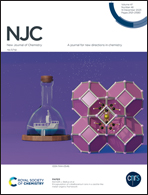Structures and magnetic studies of four new Ni(ii) coordination polymers built using symmetrical tetracarboxylate and N-donor linkers†
Abstract
Four new coordination polymers (CPs), namely, [Ni(H2L)1.5(1,10-phen)(H2O)2]n(1), {[Ni(H2L) (dib)]·2H2O}n(2), {[Ni(L)0.5(bix)]·H2O}n(3), and [Ni(L)(dpa)0.5(H2O)]n(4) (H4L = 5,5'-(ethene-1,2-diyl)diisophthalic acid; 1,10-phen= 1,10-phenanthroline; dib= 1,4-bis(1H-imidazol-1-yl)benzene; bix = 1-(4-((1H-imidazol-1-yl)methyl)benzyl)-1H-imidazole; and dpa = (E)-1,2-di(pyridin-4-yl)diazene), exhibit diverse coordination modes of the H4L ligand and fascinating crystal structures. Complex 1 displays a one-dimensional chain structure constructed from H2L2− ligands. 2 presents a 2D 2-fold interpenetrating framework, while 3 and 4 have similar 3D (4,6)-connected topology structures. Different auxiliary linkers may be able to induce different conformations and coordination modes of H4L and have an impact on the resulting networks, according to the structural variety of complexes. In addition, the magnetic properties of 1–4 were investigated in detail, which revealed that either weak ferromagnetic or antiferromagnetic interactions occurred between Ni(II) centers in 1–4. Hirshfeld surface analysis is employed to explore the noncovalent interactions that are responsible for crystal packing quantitatively.



 Please wait while we load your content...
Please wait while we load your content...